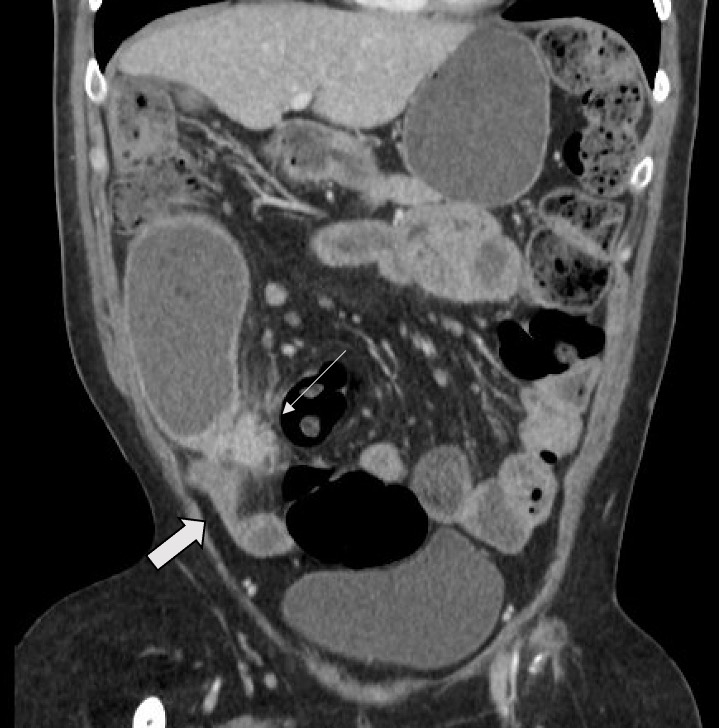Case: A 40-year-old woman presented with 20 years of episodic central abdominal pain associated with nausea, vomiting, and obstipation consistent with recurrent small bowel obstructions (SBO). She had necrotizing enterocolitis (NEC) in infancy, requiring laparotomy with multiple bowel resections, possible stricturoplasty, and a temporary diverting ostomy. Medical records from that time are unavailable but the patient, a reliable historian, states she underwent no further abdominal operations after her ostomy takedown and was doing well until these episodes started around 20 years later. Each episode resolved with bowel rest, but they became more frequent in recent years and prompted gastroenterology workup. CT enterography revealed a 5cm stricture in the distal ileum (Image 1, thick arrow) with an adjacent 2.9cm mesenteric mass (Image 1, thin arrow) and proximal ileal dilation. Retrograde balloon-assisted enteroscopy was performed and demonstrated an ulcerated subepithelial mass in this area (Image 2); biopsy was negative for malignancy. The patient was referred to General Surgery for elective resection of the small bowel segment in question. Robot-assisted right hemicolectomy was performed with intraoperative findings including small bowel adhesions to the distal ileum, chronic inflammation, phlegmon encasing 15-20cm of distal ileum, and dilated proximal bowel. Inspection on the back table revealed inflamed ileal mucosa and stricture. Pathology findings were notable for a sinus tract consistent with a site of prior perforation, with the stricture in question potentially resulting from a prior anastomotic site. The patient recovered well postoperatively and has had no recurrence of symptoms.
Discussion: SBO secondary to the sequelae of NEC, its surgical treatment, and adhesive disease following laparotomy in infancy have been described as etiologies of SBO in infants and children. However, to our knowledge there have been no prior descriptions of SBO in adults resulting from anastomoses made in the surgical treatment of NEC; indeed, the long-term outcomes of laparotomy for any indication in infants have not been well-described. As outcomes and survival have improved over time for both surgical and medical management of NEC, these occurrences may become more frequent as these patients age and present with sequelae later in life. Thus, we think it important to consider sequelae of NEC in the differential of patients with SBO who had NEC and/or underwent bowel resection in infancy.

